2017-11-16 - Nº 133
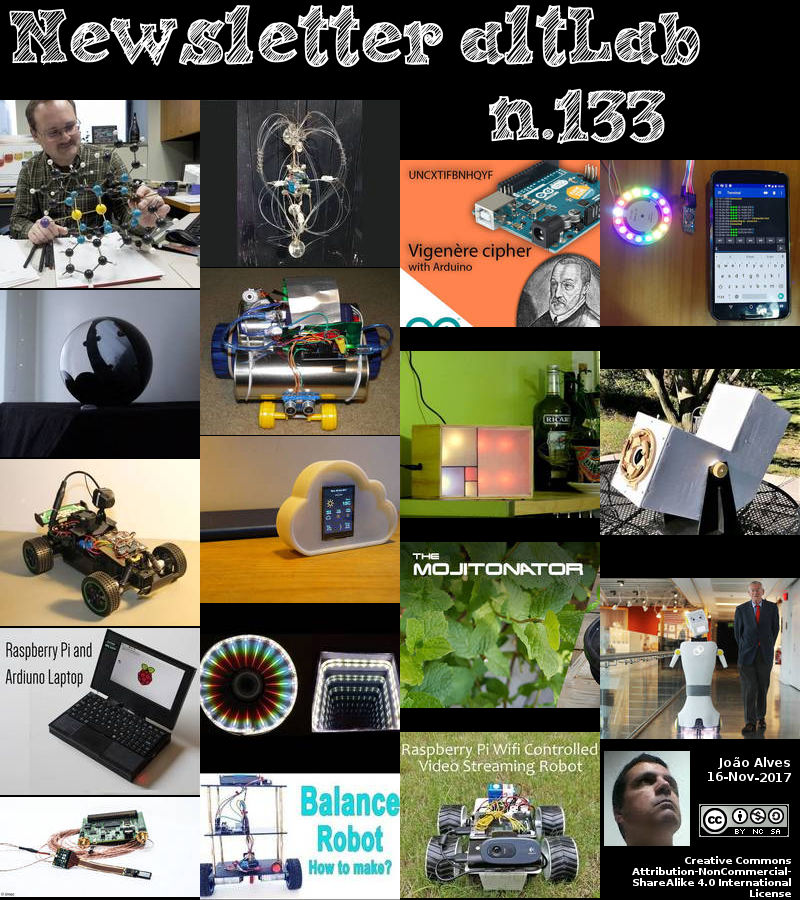
Editorial
Esta é a Newsletter Nº 133 que se apresenta com o mesmo formato que as anteriores. Se gostar da Newsletter partilhe-a!
Todas as Newsletters encontram-se indexadas no link.
Esta Newsletter tem os seguintes tópicos:
Faz hoje anos que nascia, em 1717, Jean le Rond d'Alembert. Este matemático francês ficou conhecido pelo seu trabalho em vários campos da matemática aplicada, em particular o da dinâmica. Em 1743 publicou seu "Traité de Dynamique", no qual aplica a terceira lei do movimento de Newton, em que a lei de Newton não só é válida para os corpos fixos, mas também para os corpos em movimento livre. D'Alembert também escreveu sobre a dinâmica dos fluidos, a teoria dos ventos, as propriedades das cordas vibratórias e experiências conduzidas sobre as propriedades do som. A sua inovação puramente matemática mais significativa foi sua invenção e desenvolvimento da teoria das equações diferenciais parciais.
Faz também anos hoje que nascia, em 1835, Eugenio Beltrami. Este Matemático e físico matemático italiano ficou conhecido pelos seus conceitos de geometria não euclidiana. Em 1865, ele publicou um artigo sobre como elementos de linha nas superfícies de curvatura constante poderiam ser representados por expressões lineares. A sua abordagem ofereceu uma nova representação da geometria de curvatura constante que era consistente com a teoria euclidiana. Beltrami estudou elasticidade, teoria das ondas, óptica, termodinâmica e a teoria do potencial. Foi o primeiro a explorar os conceitos de hiperespaço e tempo como uma quarta dimensão. As suas investigações na condução de calor levaram a equações diferenciais parciais lineares. Alguns dos últimos trabalhos de Beltrami estavam numa interpretação mecânica das equações de Maxwell.
Por fim, faz anos hoje que nascia, em 1841, Jules Violle. Este físico francês nascido em Langres, fez a primeira determinação de altitude da constante solar (em 1875, no Mont Blanc nos Alpes franceses e suíços). Ele também determinou os pontos de fusão de paládio, platina e ouro. Violle também estava interessado na teoria dos geysers, na origem do granizo e na exploração atmosférica através de amostragens por balão. Para radiação de alta temperatura, ele propôs uma unidade fotométrica, a violle ou o padrão de Violle (1881). Seu actinômetro é uma forma de pirheliômetro, um dispositivo para medir a intensidade da luz solar. Foi modificado a partir da invenção de John Herschel de 1825. Ele consiste em duas esferas concêntricas vazias contendo água entre elas. A luz do sol passa através de uma abertura e cai sobre uma lâmpada do termómetro na esfera interna oca.
Na semana que passou ficámos a saber que a Waymo agora está a testar os seus carros autónomos na via pública sem ninguém ao volante. Os testes também não estão limitados a uma ou duas rotas; A área de teste onde os ensaios verdadeiramente sem condutor estão a ser realizados é em Chandler, Arizona (parte da área metropolitana de Phoenix), e os carros podem ir a qualquer lugar dentro desse espaço definido. É difícil subestimar a importância deste marco: a Waymo está a operar em autonomia de nível 4, partilhando estradas públicas com carros e pedestres humanos, sem que ninguém no volante possa assumir o controlo, caso as coisas não funcionem como planeado.
Também esta semana uma equipa médica alemã procedeu à troca de cerca de 80 porcento da pele de uma criança de sete anos. Esta medida foi necessária para salvar a vida da criança que tinha uma patologia rara que lhe provocava feridas e bolhas expostas. Uma unidade de queimados tentou, sem sucesso, um tratamento convencional. Os médicos retiraram uma pequena amostra de pele de um dos poucos lugares no corpo da criança, que não estava afectada, e enviou para o prof. De Luca. A sua equipa no centro usou um vírus para inserir nas células da pele uma cópia correta de um gene chamado LAMB3; A própria cópia defeituosa do menino causou sua epidermólise bolhosa. De Luca e seus colegas cresceram as células da pele sobre estruturas artificiais no seu laboratório para formar grandes pedaços. Estes foram posteiormente aplicados em duas cirurgias na criança.
Ainda esta semana, Linus Torvalds anunciou a versão 4.14 do Kernel Linux. Esta versão tem um significado especial por ser de suporte longo (LTS). Apelidado de "Fearless Coyote", esta versão traz como novidades uma maior capacidade de endereçamento de memória na arquitectura x86_64, melhorias VEGA, suporte para compressão zstd adicionado, AMD Secure Memory Encryption em CPUs EPYC, novo driver wifi realtek, melhorias nos filesystems F2FS para Android e Btrfs, EXT4, XFS, etc.
Na Newsletter desta semana apresentamos diversos projetos de maker assim como dois modelos 3D que poderão ser úteis. É apresentado também o livro "Don't Panic: Mobile Developer's Guide to The Galaxy, 17th Edition".
 João Alves ([email protected])
João Alves ([email protected])
O conteúdo da Newsletter encontra-se sob a licença  Creative Commons Attribution-NonCommercial-ShareAlike 4.0 International License.
Creative Commons Attribution-NonCommercial-ShareAlike 4.0 International License.
Novidades da Semana

Waymo now testing its self-driving cars on public roads with no one at the wheel
"Waymo recently hosted a number of journalists at its private Castle testing compound, and treated us to rides with no safety driver behind the wheel – now, the former Google self-driving car company is going farther still, however, launching public road tests of its autonomous Chrysler Pacifica minivans with no safety driver on board. The tests aren’t limited to one or two routes, either; the test area where the truly driverless trials are being conducted is in Chandler, Arizona (part of the greater Phoenix metro area), and the cars are able to go anywhere within this defined space. It’s hard to understate the importance of this milestone: Waymo is operating at full Level 4 autonomy, sharing public roads with human-driven cars and pedestrians, with no one at the wheel able to take over in case things don’t go as planned. That shows confidence – confidence that Waymo has managed to achieve truly capable L4 autonomy within the specific domain of Chandler. The current passengers for this test are Waymo employees, however, so it’s not as if the Alphabet-owned company is throwing caution to the wind; instead, it’s showing that it’s ready to move to the next major phase of operations after around a decade of working on this incredibly complex problem. Waymo CEO John Krafcik announced the fully driverless trials at Web Summit today, and revealed the video above, and also noted that while the trial is starting with employees first, it’s soon going to expand to the existing members of the Chandler driverless ride hailing service trial that Waymo kicked off at the beginning of 2017." [...]

Massive Skin Replacement Saves Child’s Life
"The German doctors realized they had to do something drastic or their seven-year-old patient would die. The boy had escaped war-ravaged Syria with his parents, and a rare genetic disease had left him with raw, blistering sores over 80 percent of his body. His doctors in a children’s burn unit tried everything they could to treat his illness, called junctional epidermolysis bullosa—even grafting some skin from his father to see if it would heal the child’s wounds. But his body rejected this. Finally, they e-mailed Michele De Luca, a researcher in Italy, to ask for help. Twelve years earlier De Luca, director of the University of Modena and Reggio Emilia’s Center for Regenerative Medicine had successfully used gene therapy to restore skin on the legs of someone with a similar disease." [...]

Linux Kernel 4.14 LTS Released: Check Out The New And Best Features
"Last month, in September, Linux kernel developer Greg Kroah-Hartman confirmed on his blog Linux kernel 4.14 as the next LTS kernel, which will be supported for at least two years; this number has recently been increased to six years. As a result, the development cycle of Linux 4.14 got a week longer than usual and we witnessed eight Release Candidates. 4.14 LTS “Fearless Coyote” is here Linux kernel 4.14, codenamed “Fearless Coyote,” has been released by Linus Torvalds. “The appended shortlog is obviously only for the (small) haul since rc8, and it really is tiny. Not very many commits, and they are small,” Torvalds wrote his Linux Kernel Mailing List announcement. He also took time to mention how 0day robot has been getting better." [...]
Outras Notícias

Hewlett Packard Enterprise Introduces Blockchain as-a-Service Solution for Enterprises
"Hewlett Packard Enterprise (NYSE: HPE) today announced the first product in the HPE Mission Critical Blockchain family. Mission Critical Distributed Ledger Technology (DLT) is a solution that enables customers to run distributed ledger workloads on the highest availability enterprise platforms. Mission Critical DLT is a distributed ledger technology that is used to record transactions across a decentralized network of computers and has a wide range of potential applications across industries. According to Gartner, blockchain will generate $176 billion in business value by 2025. [1] Enterprises evaluating blockchain solutions are finding that generic infrastructure and public cloud environments cannot support the requirements they need in terms of performance, security, scalability and resiliency. HPE’s Mission Critical DLT solution offers availability and fault protection for enterprise-grade applications." [...]

Intel Doubles Capacity of World’s Most Responsive Data Center SSD
"Today, Intel announced the Intel® Optane™ SSD DC P4800X Series, the world’s most responsive data center solid state drive, is now available in a new 750GB capacity in both half-height, half-length add-in card and a hot-swappable 2.5-inch U.2 form factor. Both form factors and capacities will be broadly available this month. Increased capacity and multiple form factors expand data center implementation options and deliver both solution-level and total cost of ownership flexibility for customers. Intel® Optane™ technology for data centers combines the attributes of memory and storage with low latency, high endurance, outstanding quality of service and high throughput, creating a new data tier that increases scale per server and reduces transaction costs. Combined with the latest Intel® Xeon® Scalable processors, Intel® Optane™ technology enables bigger and more affordable data sets to gain new insights from larger memory pools. The Intel® Optane™ SSD DC P4800X is an ideal SSD for storage workloads, like SAN and software defined storage, as well as cloud, database, big data and high-performance computing workloads." [...]
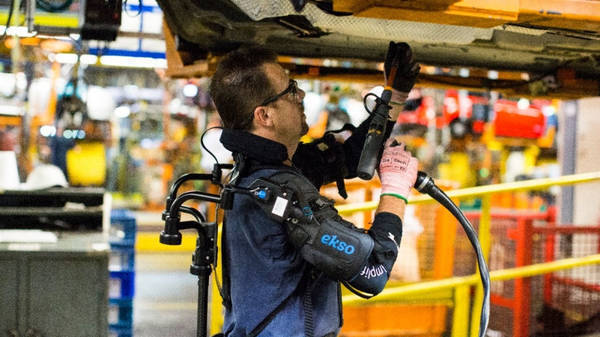
Ford Pilots New Exoskeleton Technology To Help Lessen Chance Of Worker Fatigue, Injury
"Called EksoVest, the wearable technology elevates and supports a worker’s arms while performing overhead tasks. - Ford assembly line workers are testing new upper body exoskeletal technology – EksoVest – that helps lessen the chance of fatigue or injury while performing overhead tasks - EksoVest is the latest example of advanced technology Ford is using to reduce the physical toll on employees during the vehicle assembly process - Since 2005, incidents in Ford’s North America facilities that resulted in time away from the job fell 83 percent; the 2016 incident rate was the lowest on record Putting dishes on a high shelf or changing an overhead lightbulb occasionally might not be difficult, but could you imagine performing either of these tasks 4,600 times per day? How about 1 million times a year? These are the approximate number of times some Ford assembly line workers lift their arms during overhead work tasks. At this rate, the possibility of fatigue or injury on the body increases significantly. But a new upper body exoskeletal tool – the result of a partnership between Ford and California-based Ekso Bionics – helps lessen the chance of injury." [...]

Imec designs and fabricates world-first miniature neural probe for simultaneous recording of multiple brain regions at neuronal resolution
"Imec, the world-leading research and innovation hub in nano-electronics and digital technologies, has designed and fabricated a breakthrough neural probe for the parallel recording of hundreds of neural signals. The Neuropixels probe was developed for an international consortium consisting of Howard Hughes Medical Institute (HHMI), the Allen Institute for Brain Science, the Gatsby Charitable Foundation and Wellcome, with funding of $5.5 million.Scientists at HHMI’s Janelia Research Campus, the Allen Institute and University College London (UCL) worked together with engineers at nanotechnology company imec to build and test the probes that were designed and fabricated on imec’s advanced silicon platform, demonstrating its ability to create ultraprecise tools which are being recognized as a new gold standard in neuroscience research. The results were published in an edition of Nature this month and will also be presented at the Annual Meeting of the Society for Neuroscience in Washington, D.C., Nov. 11-15, 2017. Current techniques to map the activity of brain cells either lacked spatial or temporal resolution. Previous generations of neural probes can only record activity of a few dozen neurons, while optical imaging lacks in speed to distinguish individual spikes of activity. Imec’s Neuropixels probe solves both issues and enables precise real-time recording of the activity of hundreds of individual neurons." [...]
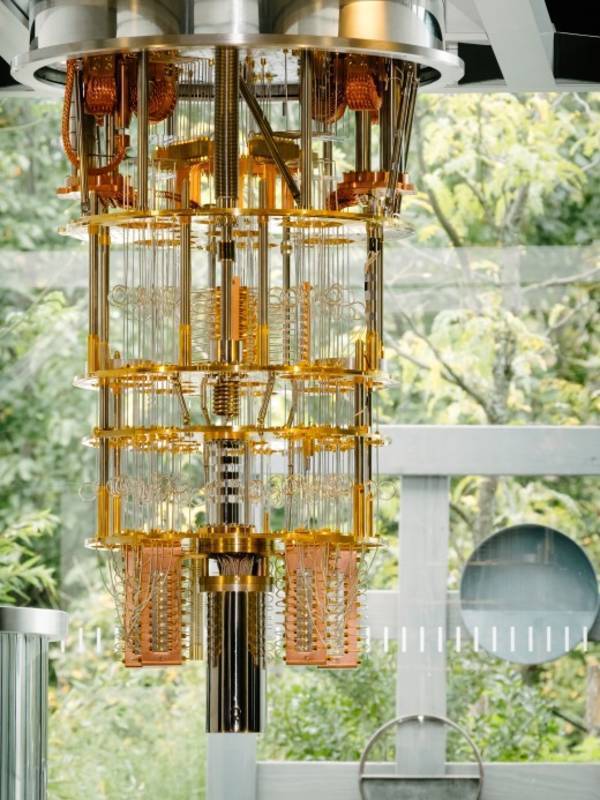
IBM Raises the Bar with a 50-Qubit Quantum Computer
"IBM established a landmark in computing Friday, announcing a quantum computer that handles 50 quantum bits, or qubits. The company is also making a 20-qubit system available through its cloud computing platform. IBM, Google, Intel, and a San Francisco startup called Rigetti are all currently racing to build useful quantum systems. These machines process information in a different way from traditional computers, using the counterintuitive nature of quantum physics. The announcement does not mean quantum computing is ready for common use. The system IBM has developed is still extremely finicky and challenging to use, as are those being built by others." [...]
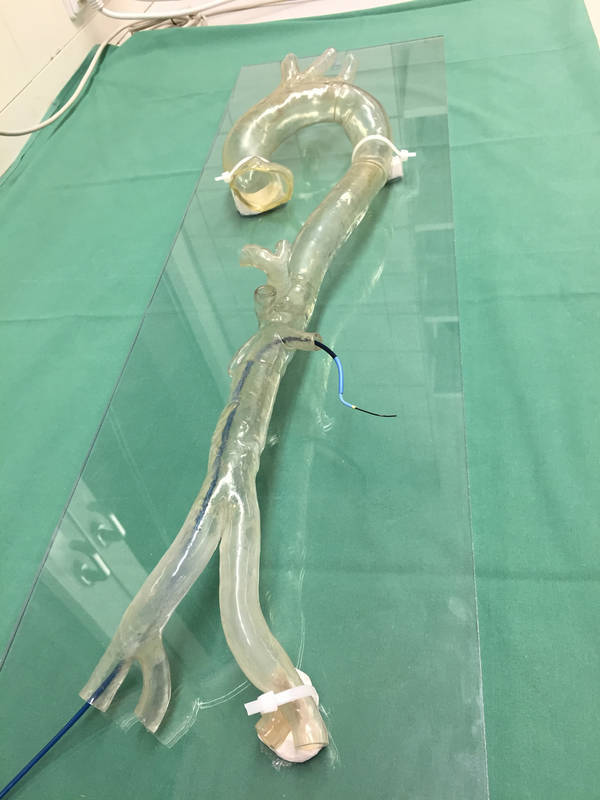
German University Hospital Mainz Pioneers Surgical Planning for Life-Saving Vascular Surgeries With 3D Printing
"Surgeons treat 53yr old woman turned down by several other hospitals due to illness complexity, with surgical 3D printed models integral to understanding the cause of the issue and best determining the type of treatment required to successfully operate Stratasys Ltd. (Nasdaq:SSYS), a global leader in applied additive technology solutions, today announced that surgeons at the University of Mainz Cardiothoracic and Vascular Surgery Department are using Stratasys PolyJet 3D printing to transform the hospital’s surgical planning process for complex, life-critical vascular cases. According to the University hospital, the use of 3D printed models for surgical planning has seen a significant reduction in costs at the institution when designing and fitting implants - while the hospital reports relevant time-savings during surgery, leading to an improvement in patient outcomes. As an internationally recognized Center of Excellence when it comes to its Cardiothoracic and Vascular Surgery, the University Hospital Mainz provides research and patient care in areas related to the heart, thorax and blood vessels in the human body. The hospital treats several patients suffering from life-threatening aortic illnesses needing immediate attention and complex, patient-specific surgical treatment. According to Prof. Dr. Bernhard Dorweiler, Head of the Department of Vascular Surgery at University Hospital Mainz, the adoption of 3D printing is playing a crucial role in elevating the standard of patient care. “On average, CT scans with 1000-2000 images can be made per vascular-related patient case, which the surgeons use to analyze and diagnose the illness." [...]

Lava or Not, Exoplanet 55 Cancri e Likely to have Atmosphere
"Twice as big as Earth, the super-Earth 55 Cancri e was thought to have lava flows on its surface. The planet is so close to its star, the same side of the planet always faces the star, such that the planet has permanent day and night sides. Based on a 2016 study using data from NASA's Spitzer Space Telescope, scientists speculated that lava would flow freely in lakes on the starlit side and become hardened on the face of perpetual darkness. The lava on the dayside would reflect radiation from the star, contributing to the overall observed temperature of the planet. Now, a deeper analysis of the same Spitzer data finds this planet likely has an atmosphere whose ingredients could be similar to those of Earth's atmosphere, but thicker. Lava lakes directly exposed to space without an atmosphere would create local hot spots of high temperatures, so they are not the best explanation for the Spitzer observations, scientists said." [...]
Ciência e Tecnologia
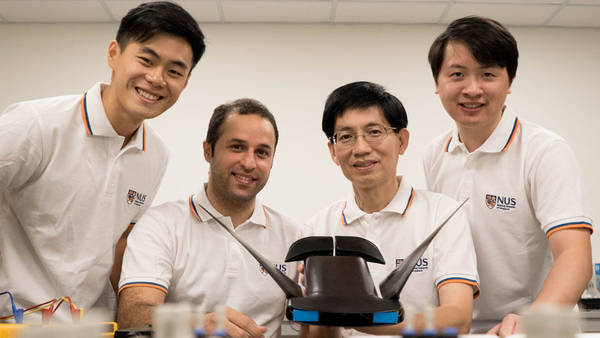
NUS-developed manta ray robot swims faster and operates up to 10 hours
"The nature-inspired robot could one day substitute traditional autonomous underwater vehicles Researchers from the National University of Singapore (NUS) have created MantaDroid, an aquatic robot that emulates the swimming locomotion of manta rays. The robotic manta ray, which swims at the speed of twice its body length per second and can operate for up to 10 hours, could potentially be employed for underwater surveillance in future. Manta rays are considered one of nature’s most graceful and efficient swimmers. Unlike most underwater species, manta rays possess a unique propulsion mechanism that enables them to cruise through turbulent seas by flapping their pectoral fins effortlessly. This distinctive feature has sparked great interests in understanding the science behind the mechanism and to incorporate similar mechanisms into autonomous underwater vehicles (AUVs). Motivated to develop a bio-inspired AUV, a research team led by Associate Professor Chew Chee Meng and Associate Professor Yeo Khoon Seng from the Department of Mechanical Engineering at NUS Faculty of Engineering developed MantaDroid, which resembles a juvenile manta ray." [...]

Researchers teach computer to recognize emotions in speech
"Experts of the Faculty of Informatics, Mathematics, and Computer Science at the Higher School of Economics have created an automatic system capable of identifying emotions in the sound of a voice. Their report was presented at a major international conference - Neuroinformatics-2017. https://link.springer.com/chapter/10.1007/978-3-319-66604-4_18 For a long time, computers have successfully converted speech into text. However, the emotional component, which is important for conveying meaning, has been neglected. For example, for the same question 'Is everything okay? ', people can answer 'Of course it is!'" [...]
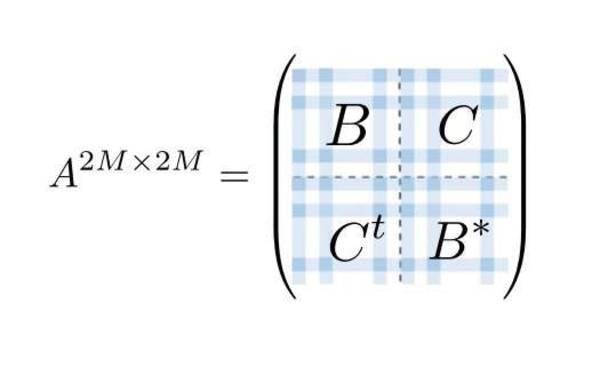
Hard computing problem might be solvable only by quantum computers
"Researchers have introduced a new computing problem and shown that it would be extremely difficult, if not impossible, for a classical computer to solve, but in theory it could be efficiently solved using quantum techniques. The problem, which is called Gaussian boson sampling, is a new version of boson sampling, which is a similar computing problem that was introduced a few years ago with the goal of demonstrating the potential advantages of quantum computers over classical ones. The researchers of the new study, Craig S. Hamilton et al., from the Czech Technical University in Prague and the University of Paderborn in Germany, have published a paper on Gaussian boson sampling in a recent issue of Physical Review Letters. Overall, the Gaussian boson sampling problem is very similar to the original boson sampling problem, which was proposed in 2011 by Scott Aaronson and Alex Arkhipov. In both problems, the task is to find the probability of measuring certain patterns of photons emerging from an optical system, given a certain input configuration of photons. In complexity theory, boson sampling is conjectured to be a #P-hard problem, which makes it extremely unlikely that it could be solved by a classical computer." [...]
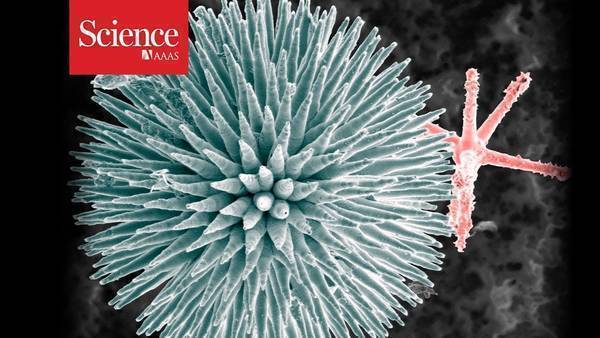
Marine Sponges & Novel Glass Technology
"The technology for glass forming and shaping requires heat treatment at high temperatures of about 1000o C. So it has long been a mystery how it is that certain marine organisms are able to form glass architectures (called spicules) in cold water. Now, a paper published recently in Science Advances by Professor Emil Zolotoyabko, of the Technion-Israel Institute of Technology, and colleagues in Germany, headed by Dr. Igor Zlotnikov from TU Dresden, is helping to unravel that mystery. Using the most advanced X-ray methods, nano-tomography and focused X-ray diffraction, available at the European Synchrotron Radiation Facility (ESRF, Grenoble, France), the group uncovered the principles of spicule morphogenesis in certain kinds of marine sponges. Marine sponges are one of the oldest multicellular organisms, with a fossil record that stretches back more than half a billion years. Demospongiae and Hexactinellida, two classes of sponges, synthesize mineralized silica-based skeletal elements, called glass spicules, which provide the animals with structural support and mechanical strength and help protect them from their environment. The spicules are microns to millimeters long and exhibit a diversity of highly regular three-dimensional branched morphologies that are an example of symmetry in biological systems (Fig." [...]
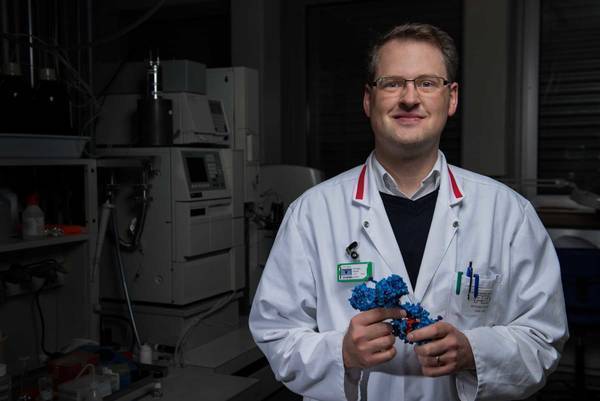
A new bio-robot
"With a new method for modifying antibodies, Philipp Spycher wants to develop drugs that are more stable and, thus, have fewer side-effects. Isaac Newton is said to have had his “Eureka!” moment when an apple fell on his head. Philipp Spycher had the idea that inspired him in a Key West hotel room in August 2015, when he couldn't sleep and needed to get moving. At the time Spycher, a postdoctoral radiopharmaceutical researcher at the Paul Scherrer Institute PSI, was concerned with the question of how active agents could be bound to antibodies more efficiently. That's because, in combination with an antibody, the active agent can target the diseased cells in the body and, thus, can take effect in the right place. With the conventional method, the active agent is chemically attached to the antibody." [...]

Manchester leading the way in robotics and AI for nuclear industry
"Researchers at The University of Manchester's Dalton Nuclear Institute will lead a new multimillion pound robotic and artificial intelligence (AI) programme aiming to clean up the world’s nuclear waste. Led by Professor Barry Lennox, Professor of Applied Control in the School of Electrical & Electronic Engineering, the new Robotics and Artificial Intelligence for Nuclear (RAIN) Hub has been awarded £12 million to tackle some of the biggest challenges facing the nuclear industry. The hub will undertake world-leading research and develop innovative technologies to address issues such as decommissioning, waste management, fusion, plant life extension and new site builds. Whilst being led by Manchester, RAIN brings together expertise from the Universities of Oxford, Liverpool, Sheffield, Nottingham, Lancaster, Bristol and the UK Atomic Energy Authority (UKAEA), as well as international partners from the US, Italy and Japan. Prof Lennox, who is also part of the University's Dalton Nuclear Institute, says: "This is excellent news, not just for the universities involved, but the entire energy and nuclear sectors. It is also a testament to the world-leading research we are doing right here in Manchester." [...]
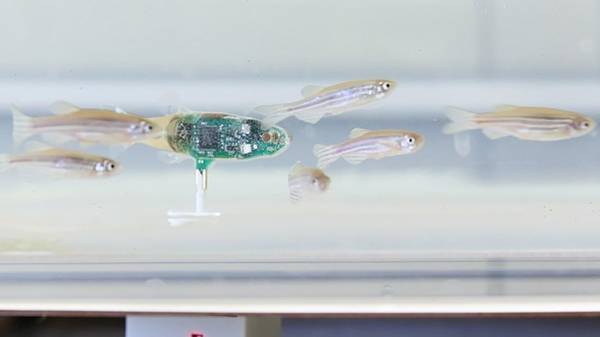
A robotic spy among the fish
"Researchers at EPFL’s Robotic Systems Laboratory (LSRO), which is headed by Professor Francesco Mondada, have developed a miniature robot that can integrate perfectly into schools of zebrafish. Their work was carried out as part of an EU research program among six partner institutions,* and the findings were recently published in Bioinspiration & Biomimetics. “We created a kind of ‘secret agent’ that can infiltrate these schools of small fish,” says Frank Bonnet with a smile. Bonnet is a post-doc researcher at the LSRO and one of the study’s authors. The robot is seven centimeters long – longer than the fish it’s modeled after but with the same shape and proportions. It is equipped with magnets that link it to a tiny engine installed under the aquarium to propel it through the water." [...]
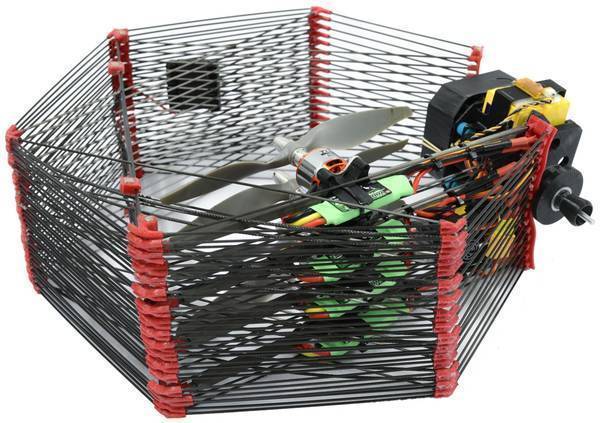
A drone for last-centimeter delivery
"A new drone developed at EPFL uses cutting-edge technology to deliver parcels weighing up to 500 grams. The device will never get stuck in traffic, it’s programmed to avoid obstacles, and it can reach destinations on the steep or uneven terrain. Its protective cage and foldable design mean that it can be carried around in a backpack and used in total safety. With a drone, things like letters, medicine, first-aid supplies and food can be delivered quickly, cheaply and autonomously without having to worry about traffic, blocked roads or a lack of roads. Some companies will surely come to rely on these drones. And engineers will be called on to develop ever more sophisticated models to keep pace with this new facet of e-commerce." [...]

Transfer Technique Produces Wearable Gallium Nitride Gas Sensors
"A transfer technique based on thin sacrificial layers of boron nitride could allow high-performance gallium nitride gas sensors to be grown on sapphire substrates and then transferred to metallic or flexible polymer support materials. The technique could facilitate the production of low-cost wearable, mobile and disposable sensing devices for a wide range of environmental applications. Transferring the gallium nitride sensors to metallic foils and flexible polymers doubles their sensitivity to nitrogen dioxide gas, and boosts response time by a factor of six. The simple production steps, based on metal organic vapor phase epitaxy (MOVPE), could also lower the cost of producing the sensors and other optoelectronic devices. Sensors produced with the new process can detect ammonia at parts-per-billion levels and differentiate between nitrogen-containing gases. The gas sensor fabrication technique was reported November 9 in the journal Scientific Reports." [...]

A simple soak for a solar tune-up
"The performance of solar cells that consist of semiconductor nanoparticles surrounded by ligand molecules is now easier to control. Researchers from KAUST have developed a method that enhances the ability of these colloidal quantum dot (CQD) solar cells to convert the sun’s energy into electricity by altering the surface chemistry of their functional layers in a noninvasive way1, 2. CQDs, such as lead sulfide, are readily processed in solution and benefit from highly tunable and narrow light-emission ranges, depending on their size and composition. “This makes them compelling building blocks for light-harvesting, detection, and emission technologies,” says materials engineer, Aram Amassian, who led the team. Recent breakthroughs in solution-phase exchange and device engineering, such as large-area, lost-cost techniques that use ink-based coating and printing for material deposition, mean that CQD solar cells hold potential for high-performance photovoltaic devices. The CQD surface chemistry serves multiple, simultaneous and often competing purposes: these include stabilizing the colloidal ink and maintaining nanoparticle cohesion in the solid." [...]

Future robots won’t resemble humans – we’re too inefficient
"Humanoid robots are a vanity project: an attempt to create artificial life in our own image – essentially trying to play God. The problem is, we’re not very good at it. Ask someone on the street to name a robot and you might hear “Terminator”, “the Cybermen” or “that gold one from Star Wars”. What you’re not going to be given are names like Tesla Model X, Cassini or DJI Inspire 2. These are all robots, but they don’t follow the sci-fi narrative of what robots should be like. The fact is, the robots of the near future won’t be going about on two legs like the shuffling C3PO." [...]
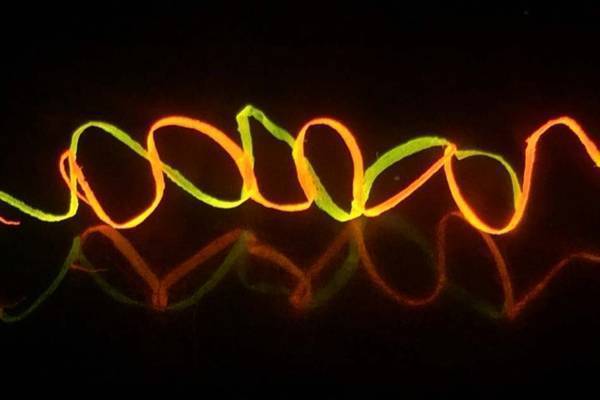
How to build better silk
"When it comes to concocting the complex mix of molecules that makes up fibers of natural silk, nature beats human engineering hands down. Despite efforts to synthesize the material, artificial varieties still cannot match the natural fiber’s strength. But by starting with silk produced by silkworms, breaking it down chemically, and then reassembling it, engineers have found they can make a material that is more than twice as stiff as its natural counterpart and can be shaped into complex structures such as meshes and lattices. The new material is dubbed regenerated silk fiber (RSF) and could find a host of applications in commercial and biomedical settings, the researchers say. The findings are reported in the journal Nature Communications, in a paper by McAfee Professor of Engineering Markus Buehler, postdoc Shengjie Ling, research scientist Zhao Qin, and three others at Tufts University. Some kinds of silk produced by spiders are among the strongest materials known, pound for pound." [...]
Semiconductors with an aligned interface
"Efficiency gains come from tuning the properties of semiconducting materials by combining layers of different composition. The electronic characteristics of an interface between two wide bandgap semiconductors are determined by researchers at KAUST: an insight that will help improve the efficiency of light-emitting and high-power electronic devices. Semiconductors, such as silicon and gallium nitride, have electrical properties somewhere in between those of a conductor and an insulator. They only allow current to flow when electrons have enough energy to overcome a barrier known as bandgap. The bandgap—which may be direct or indirect, narrow or large—determines the properties of semiconductors and their consequent applications. Materials with a large bandgap, for example, are useful in high-power electronics because they have larger breakdown voltage for energy-efficient transistors as compared with narrow bandgap materials, such as silicon." [...]

Research drive could ‘untangle’ vexing problem in computer-simulation technology
"The computer simulations used to design, optimize, test or control a vast range of objects and products in our daily lives are underpinned by finite element methods. Finite element simulations use a mesh of geometric shapes — triangles, tetrahedra, quadrilaterals or hexahedra, for instance. These shapes can be combined to form a mesh that approximates the geometry of a model. For example, meshes can be used to model the human knee in biomechanics simulations, create computer-animated movies or help developers bring products, like airplanes and cars, from concept to production more quickly via better prototypes, testing and development. “When you were a kid you played with LEGOs and thought about building different projects — like a house,” said Suzanne Shontz, associate professor of electrical engineering & computer science at the University of Kansas. “You were basically stacking blocks and building an object." [...]
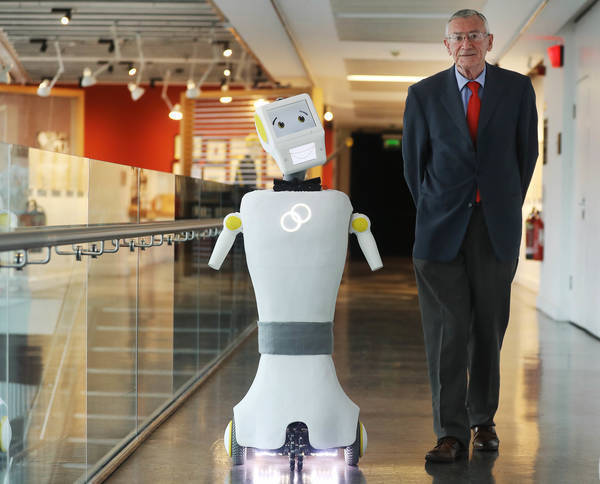
Trinity engineers unveil Ireland’s first prototype robot for assisted care
"Robotics engineers from Trinity today unveiled the first prototype robot designed to work in assisted care facilities and help the elderly and people living with disability in Ireland. The team behind the robot has very recently secured significant development funding from Enterprise Ireland to move the prototype towards a marketable model via a new start-up company. The friendly looking robot has some human-like features and performs some autonomous tasks and some that are human-controlled. It will initially be charged with performing routine tasks in nursing homes and assisted care facilities. Assistant Professor in Mechanical and Manufacturing Engineering at Trinity, Conor McGinn, spearheads the Innovation and Robotics Lab. Professor McGinn said: “Nursing homes face significant care challenges, especially during the night when caregiver-to-resident ratios are low." [...]

Channeling helium: Researchers take next step toward fusion energy
"Fusion is the process that powers the sun, harnessing it on Earth would provide unlimited clean energy. However, researchers say that constructing a fusion power plant has proven to be a daunting task, in no small part because there have been no materials that could survive the grueling conditions found in the core of a fusion reactor. Now, researchers at Texas A&M University have discovered a way to make materials that may be suitable for use in future fusion reactors. The sun makes energy by fusing hydrogen atoms, each with one proton, into helium atoms, which contain two protons. Helium is the byproduct of this reaction. Although it does not threaten the environment, it wreaks havoc upon the materials needed to make a fusion reactor." [...]
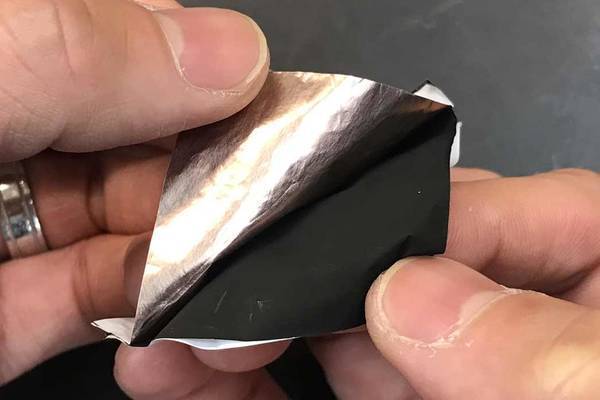
Double-duty textile developed by Stanford researchers could warm or cool
"Stanford researchers have developed a reversible fabric that, without expending effort or energy, keeps skin a comfortable temperature whatever the weather. close up of a sample of the textile separated to show the two inner layers of copper and carbon A new textile made from a reversible fabric could warm or cool wearers and keep them comfortable. Two layers of material with different abilities to release heat energy are stacked together and sandwiched between layers of polyethylene. (Image credit: Yi Cui Group) In a paper published Nov. 10 in Science Advances, a team led by Yi Cui, professor of materials science and engineering, created a double-sided fabric based on the same material as everyday kitchen wrap. Their fabric can either warm or cool the wearer, depending which side faces out. This project came out of Cui’s interest in energy efficiency and his expertise in manipulating nanoscale materials." [...]
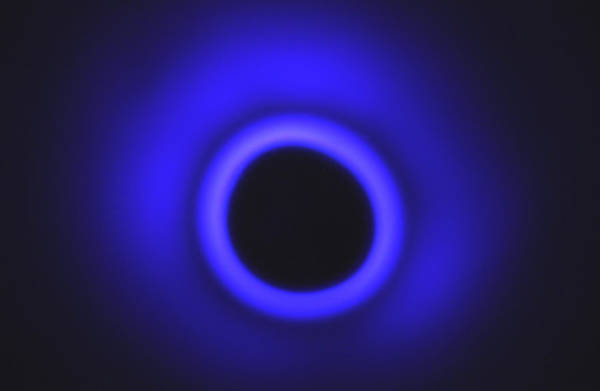
Engineers Create Stable Plasma Ring in Open Air
"For the first time, engineers at Caltech have created a stable ring of plasma in open air—essentially capturing lightning in a bottle, but without the bottle. Matter can exist in four distinct phases: solid, liquid, gas, and plasma. Plasmas are made of charged particles—ions and electrons—and occur naturally on Earth as lightning, in the weather phenomenon called St. Elmo's fire (in which glowing balls of light sometimes appear on pointed objects during storms), and in man-made objects such as fluorescent light bulbs and plasma cutting torches. Usually, plasmas do not have clearly defined shapes of their own. Lightning follows a path of least resistance through the air, creating wildly forking structures, while man-made plasmas are constrained by vacuum chambers or electromagnetic fields. As such, Morteza (Mory) Gharib (PhD '83), the Hans W. Liepmann Professor of Aeronautics and Bioinspired Engineering at Caltech, says he was surprised when he and his team were able to generate a stable ring of plasma in open air using just a stream of water and a crystal plate." [...]
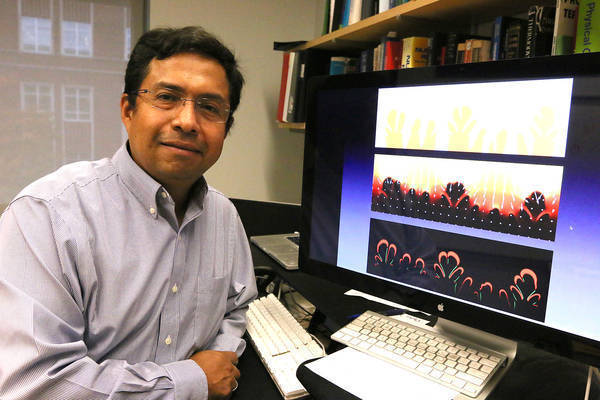
Taming ‘dendrites’ could bring better lithium-ion batteries
"Researchers have learned the mechanisms behind a common type of failure in lithium-ion batteries caused by the formation and growth of “dendrites,” findings that could aid in the design of faster-charging and longer-lasting batteries. Dendrites are lithium formations that grow inside the batteries. Because they grow faster while exposed to large electrical currents needed for fast recharging, the dendrites limit recharging speed. “We’ve all had the experience of spending two or three hours at the airport waiting for our cellphones to charge,” said Edwin García, a professor of materials engineering at Purdue University. “Better control of dendrite growth would lead to faster charging.” Batteries have two electrodes, called an anode and a cathode, separated by an insulating polymer. Dendrites that grow in needlelike shapes may breach the separating barrier, destroying the battery." [...]

Quantum Computing with Molecules for a Quicker Search of Unsorted Databases
"A universal quantum computer still is a vision. Special quantum systems that promise to solve certain tasks more quickly than a classical computer, however, are already playing an important role in science. To reliably find a certain element in unsorted data, a conventional computer has to run through all search elements successively in the most unfavorable case. A quantum system with an implemented Grover’s search algorithm quadratically accelerates search. Research teams headed by Professors Wolfgang Wernsdorfer and Mario Ruben of KIT, together with scientists of the Institut Néel (Grenoble), have succeeded in doing this: The scientists applied Grover’s algorithm to a molecular magnet and, thus, created a quantum system, whose task is the rapid finding of search elements in unsorted data. In their latest research project, they demonstrated feasibility of a quick search for a small database of four elements." [...]
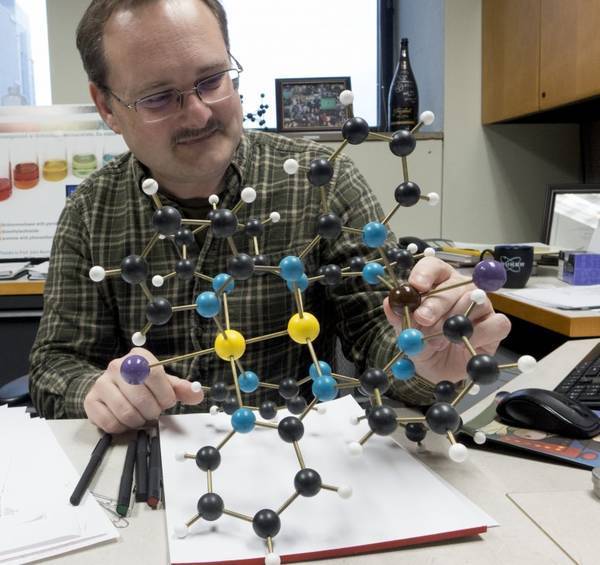
Molecular magnetism packs power with “messenger electron”
"Electrons can be a persuasive bunch, or at least, a talkative bunch, according to new work from John Berry’s lab at the University of Wisconsin–Madison. The spins of unpaired electrons are the root of permanent magnetism, and after 10 years of design and re-design, Berry’s lab has made a molecule that gains magnetic strength through an unusual way of controlling those spins. Berry says the new structure that graduate student Jill Chipman created could lead to a breakthrough in quantam computing, an approach with such great potential that it could undermine today’s silicon-based supercomputers much as the telephone did the telegraph: A great leap forward that begins a slide into irrelevance. The presence and activity, or “spin,” of unpaired electrons sets the strength of a permanent magnet, so molecules with a high degree of spin are a desirable target for chemists. The unusually large spin in the new magnetic molecule, Berry explains, results from a “messenger electron” that shuttles between an unpaired electron at each end of the rod-shaped molecule and persuades all three of them to adopt the same spin. That agreement of spin, “orthogonality” in the jargon, adds strength to a permanent magnet." [...]
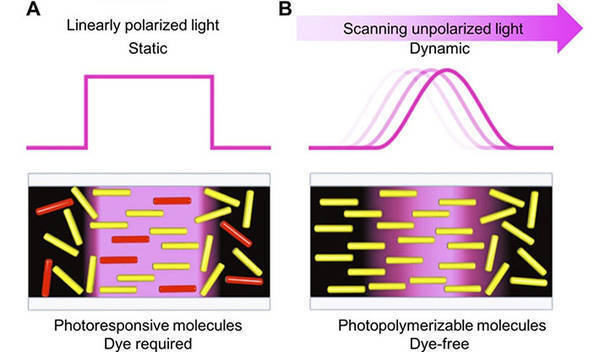
Photopolymerization-triggered molecular motion for flexible liquid crystal display
"Scientists at Tokyo Institute of Technology (Tokyo Tech) and McGill University have developed a new dye-free photoalignment method that enables 2D patterns of liquid crystals in one step by guiding nonpolarized light temporally and spatially on the photopolymerization process. This new method provides a pathway for the simple creation of highly functional organic materials such as flexible liquid crystal devices. With current 2D techniques, one typically irradiates a liquid crystal film that contains added photoresponsive dye molecules, with uniform polarized light. This controls the net liquid crystal alignment via the interaction of the dye dipole and the polarization axis of light. The drawback with these systems is the need for adding strong dyes, which can discolor or degrade optical and stability properties. Thus, a dye-free method is highly desired in the engineering industry." [...]

Method for enhancing superconductivity by laser irradiation
"A University of Tokyo research group has found that the superconductivity of materials in strongly correlated electron systems—that is, materials characterized by strong interactions between the electrons—can be enhanced beyond that achieved in thermal equilibrium by irradiation with a strong laser. The current findings hold promise of paving the way for research on regulating the superconductivity transition temperature with light, and applying the research toward developing new devices. Realizing superconductivity at room temperature is one of the Holy Grails of condensed matter physics. Although the highest critical temperature for superconductivity at ambient pressure was recorded in copper oxide superconductors (cuprates) at around minus 140 degrees Celsius decades ago, the situation has essentially remained the same despite multiple efforts to raise the temperature to within room-temperature range. One reason for this is that the strong attraction between electrons required for realizing a higher transition temperature drives the tendency to pull and clump electrons together into a nearby location, thereby forming an uneven spatial distribution of electrons, which suppresses superconductivity. In order to break through this stalemate in equilibrium, researchers have increasingly been utilizing nonequilibrium processes, such as laser irradiation, in recent years as a new way for regulating the transition temperature, and controlling and enhancing superconductivity in materials." [...]
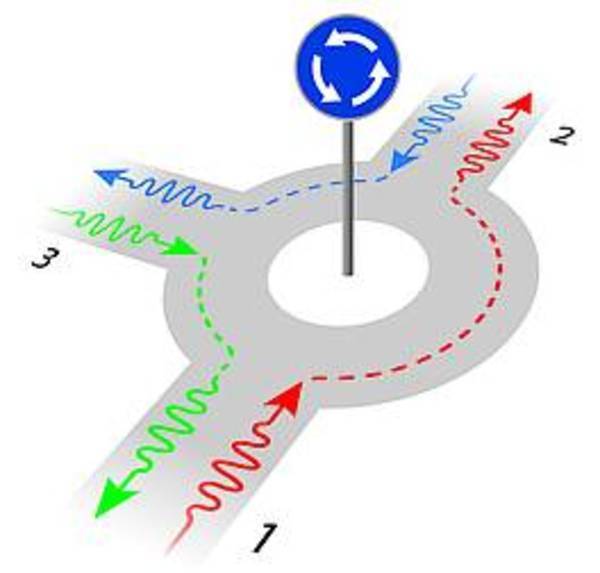
Essential quantum computer component downsized by two orders of magnitude
"Researchers at IST Austria have built compact photon directional devices. Their micrometer-scale, nonmagnetic devices route microwave photons and can shield qubits from harmful noise. Qubits, or quantum bits, are the key building blocks that lie at the heart of every quantum computer. In order to perform a computation, signals need to be directed to and from qubits. At the same time, these qubits are extremely sensitive to interference from their environment, and need to be shielded from unwanted signals, in particular from magnetic fields. It is thus a serious problem that the devices built to shield qubits from unwanted signals, known as nonreciprocal devices, are themselves producing magnetic fields." [...]

Developing “ABCs” for Exploiting New Phenomena in Light-Matter Interactions
"A unique class of engineered light-manipulating materials, known as metamaterials or structured materials, makes use of patterns of strongly interacting wavelength or sub-wavelength-sized elements. Because of these intricate internal and surface structures, new properties have emerged, some exhibiting behavior that has resulted in rewriting long-understood “laws” for how light and other electromagnetic (EM) waves interact with materials. These materials have been opening up new options for controlling EM waves in many technological arenas, among them imaging, thermal control, and frequency conversion. Specific applications include night-vision, heat reflection and management in aircraft engines, and temperature regulation of electronics on satellites in the hot-and-cold extremes of space. Although researchers have been taking steps toward putting these materials to practical use, they remain puzzled about the optimal structure designs for desired matter-light interactions. They have yet to model the materials in ways that enable predictions about how specific structured materials will behave under different conditions, such as increased illumination intensities." [...]

An acoustic cage for electrons
"The ability to trap and control electrons and other quasi-particles for the study of isolated single particles as well as many-body systems in a solid-state environment can be of major importance for understanding the behaviour of correlated electrons in technologically relevant materials. Because of their – compared to atoms – extremely small masses, these point-like particles are very fast and mobile. This, however, makes them hard to hold in place. Now, an international team of scientists around Prof. Ignacio Cirac (Max Planck Institute of Quantum Optics, Garching), and Prof. Mikhail Lukin (Harvard University, USA) have investigated a new way of building a cage for electrons (Physical Review X 7, 24 October 2017). According to their proposal electrons can be moved or held in place by electric potentials that are generated by acoustic waves on the surfaces of piezoelectric materials. Furthermore, by using counterpropagating acoustic waves lattice structures similar to optical lattices for neutral atoms can be generated." [...]

Graphene water filter turns whisky clear
"Manchester scientists use graphene water filter to turn whisky clear Previously graphene-oxide membranes were shown to be completely impermeable to all solvents except for water. However, a study published in Nature Materials, now shows that we can tailor the molecules that pass through these membranes by simply making them ultrathin. The research team led by Professor Rahul Nair at the National Graphene Institute and School of Chemical Engineering and Analytical Science at The University of Manchester tailored this membrane to allow all solvents to pass through but without compromising it’s ability to sieve out the smallest of particles. In the newly developed ultrathin membranes, graphene-oxide sheets are assembled in such a way that pinholes formed during the assembly are interconnected by graphene nanochannels, which produces an atomic-scale sieve allowing the large flow of solvents through the membrane. This new research allows for expansion in the applications of graphene based membranes from sea water desalination to organic solvent nanofiltration (OSN). Unlike sea water desalination, which separate salts from water, OSN technology separates charged or uncharged organic compounds from an organic solvent." [...]
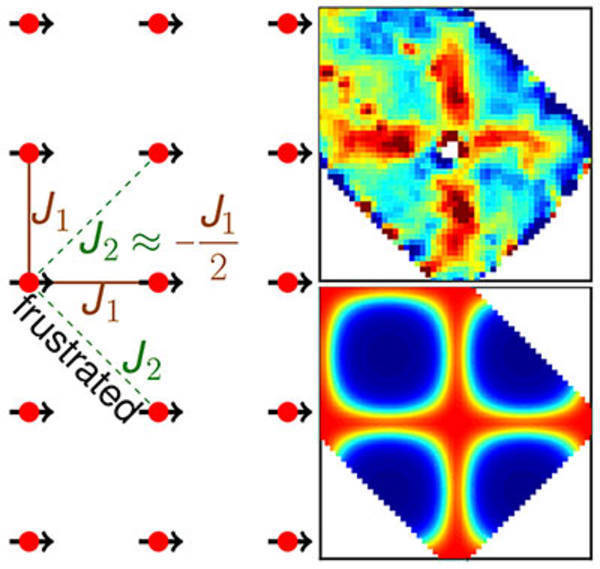
“Perfectly frustrated” metal provides possible path to superconductivity, other new quantum states
"The U.S. Department of Energy’s Ames Laboratory has discovered and described the existence of a unique disordered electron spin state in a metal that may provide a unique pathway to finding and studying frustrated magnets. Condensed matter physicists use the term “frustrated” to describe a kind of magnet in which the spins fail to align into stable magnetic order. In perfectly frustrated magnets called spin liquids, the disordered magnetism of these materials persists even at very low temperatures, and their unique properties are of interest in the development of quantum computing and high-temperature superconductivity. The materials investigated to search for this perfectly frustrated magnetic state are typically insulators. But Ames Laboratory researchers were able to define a “perfectly frustrated” state in a metallic material, CaCo1.86As2. “Perfectly frustrated systems, ones that really cannot resolve their magnetic states, are difficult to find in the first place, but even more so in a metal,” said Rob McQueeney, scientist at Ames Laboratory." [...]
Modelos 3D
Com a disponibilidade de ferramentas que permitem dar azo a nossa imaginação na criação de peças 3D e espaços como o thingiverse para as publicar, esta rubrica apresenta alguns modelos selecionados que poderão ser úteis.

PCB box generator
"This is simple generator for a PCB case.It's used to protect the PCB bottom from mount surfaceand to be simply glued to the mount area while allowing the PCB to simply slide in/out. " [...]

Parametric (Customizable) Radius Gauge
"customizable raduis-gauge (inner/outer radius).Use Customizer for other radii (then 3mm to 20mm) or thickness. " [...]
Documentação
A documentação é parte essencial do processo de aprendizagem e a Internet além de artigos interessantes de explorar também tem alguma documentação em formato PDF interessante de ler. Todos os links aqui apresentados são para conteúdo disponibilizado livremente pelo editor do livro.

Don't Panic: Mobile Developer's Guide to The Galaxy, 17th Edition
"The focus of this book is on developing mobile apps, which encompasses a number of phases including: planning and specification, prototyping and design, implementation, internal testing and deployment, deployment to an app store, discovery by users, installation, use and feedback. Ultimately, we want our users to enjoy using our apps and to give us positive ratings to encourage other users to do likewise. Keep reading to learn how to develop apps for the major platforms. Should this be the first time that you have considered getting involved, do not delay; mobile has become the predominant form of computing in many areas already. At a global scale, mobile web usage overtook desktops. Same applies for games: Mobile is generating more revenue than any other gaming market today." [...]
Projetos Maker
Diversos Projetos interessantes.

kbord: Programmable Mechanical Keypad with RGB Backlight
"kbord is a programmable keypad with 15 mechanical keys, each of which can be set to execute a script when pressed. The script can be as simple as shortcut keys like ctrl+c, or as complex as creating root backdoors or grabbing passwords. Anything that can be done on keyboard can be written in the script. Multiple profiles are supported, for different programs/environments. " [...]

Rigid vs. Flexible PCBs: Which One is Best for Your Next Project?
"Learn about rigid PCBs vs. flexible PCBs, when it's better to use one type instead of the other, and learn about some manufacturing steps related to each of these PCB types. A Printed Circuit Board Is Not Always a “Board” When the term “PCB” is used, many people think of a rigid PCB (printed circuit board). However, the term PCB can refer to either a rigid PCB or a flexible PCB. Flexible PCBs are more commonly known as flex circuits, but they are also known by other names including flex boards, flexible circuit boards, flexible printed circuit boards and, more officially, flexible electronics. Flex circuits have recently gained huge popularity due to the fact that they can be shaped, bent, twisted, and folded into limitless configurations. In the end, however, rigid PCBs and flexible PCBs serve, in the most basic sense, the same ultimate function, which is connecting various electrical and mechanical components together." [...]

SPHAERA
"Creators:Deepika Dipesh, Ebba Tornrhielm, Jenny Hanell & Xiangyi Wu What is Sphaera?Sphaera is inspired by the traditional crystal ball that gives the user a glimpse into the future. However, instead of foretelling big happenings in life, Sphaera reveals the weather forecast for the next twelve hours. It is designed to be a stationary artifact in the home environment, such as in the hallway, and can preferably be placed upon a drawer to ease interacting with it. How does it work? While interacting with Sphaera, the weather is projected as a hologram inside the glass globe. In order for the hologram to be visible without placing the globe in total darkness, half of the globe is painted in pure black." [...]

How to Build a Table Tennis Game With Wireless Controller
"Creating a Pong-style table tennis game in MMF2 (Multimedia Fusion 2) is rather easy. However, to add some interest and increase MMF2s possibilities, we will combine MMF2 with a RIOTOUS devboard to make a table tennis game controlled by a wireless controller. " [...]

Room Automation for Kids
"A Google Assistant compatible box for kids (from 2 years old) to control lights and other devices in their room. Home automation is not limited to adults! This device lets children control lights and other devices in their rooms, in a fun and easy way. This project is a box with an NFC sensor and 6 colored buttons. When a kid places an RFID device on top of the box (such as a "toys-to-life" figurine) and presses a color button, it will have a direction action in his room, depending on the RFID device. Among the possible actions, you can: - Change the light color - Control the fan - Play some music - Learn colors in Chinese - Talk to the Google Assistant" [...]

Water Meter Automation
"Have you got some water meters at your home? Probably you have. How do you like to check them every month? I do not like this process because my water meters are installed in tiny dark place under the kitchen sink. Usually you should use some kind of inspection light or torch to be able to see the water meter's values. Fortunately, my water meters have the pair of wire allowing to read the data remotely." [...]
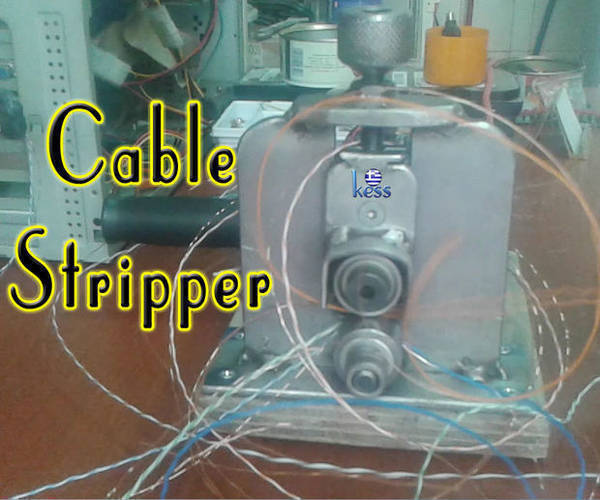
DIY Cable Stripper Machine for Recycling Copper Wires.
"Cable Stripper - Wire Stripper Machine to Recycling Copper Wires from Cables. At the first and second videos is a step by step layout guide, including materials and plans while in the third video (at last step) is a demonstration to how it works with various cables. " [...]
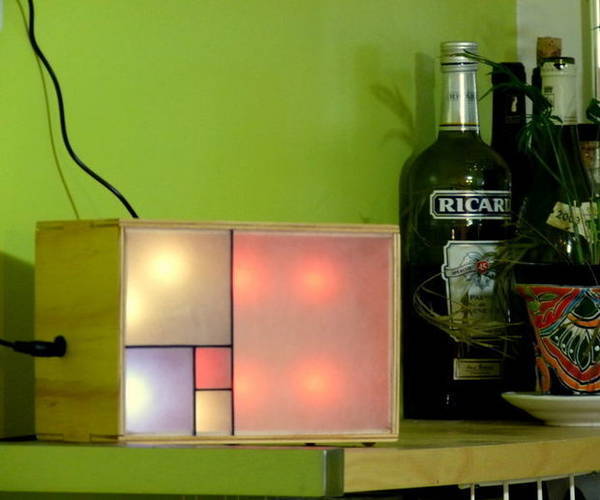
WiFibonacci Clock
"I have been inspired by the awesome Fibonacci Clock (designed by Philippe Chrtien) and I decided to make it wireless using Wifi, hence the name of WiFibonacci Clock =D The main enhancement is the replacement of the Atmega328 with an ESP8266 providing WiFi capability. This is game-changing as we can now virtualise part of the physical UI having the ESP acting as a Websocket server. Furthermore, the dematerialisation of the UI allows more tuning options. The list of existing modes that Philippe included in his design are: Current Time Rainbow Cycle Rainbow Error Code DisplayI chose to remove the Error Code Display mode and add the following list of new modes: Random Pulse Constant LightFor each mode, several settings can be tweaked. There are only two momentary buttons in my design: Mode button Brightness buttonThe brightness is also an enhancement. The time adjustment can be done via the virtual UI." [...]

Raspberry Pi and Arduino Laptop
"Since the day I heard about and got to play with the Raspberry Pi one a few years ago I've wanted to make a Raspberry Pi powered laptop out of it and now with the rease of the Raspberry Pi three I've decided to finally see it through. Now this isn't my first time attempting to make a fully working laptop using a Raspberry Pi, every other time I've tried the project has been riddled with errors with anything from broken ribbon cables to figuring out the hinge mechanism however I've been able to learn from these failures and I hope to show you how to avoid them when making your own. So lets get started! " [...]

Tap & Drag Robotic Vacuum
"A robotic vacuum made to help the elderly. We used Drawing Route for Car on the Office's Map (made by phpoc_man). This project is not completed. There is a reason why we do not use a joystick. Our team wanted to make this vacuum for patients with Parkinson's disease. This disease makes the muscles difficult to move." [...]
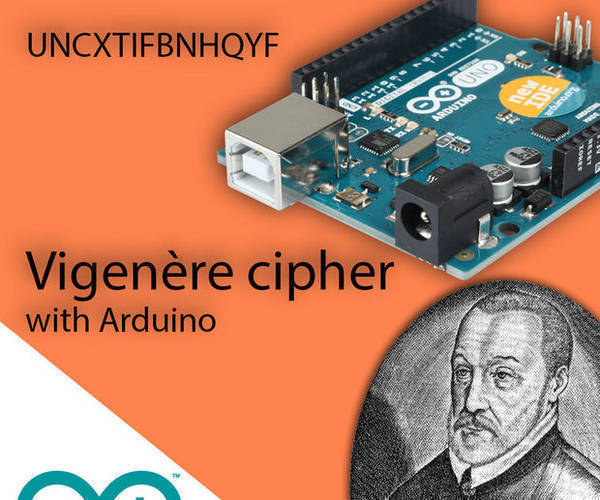
Vigenere Cipher With Arduino
"Few years ago, Digital Fortress by Dan Brown caught my attention and one particular thing stuck on my mind. Kryptos, the sculpture by Jim Sanborn which consists of ciphered text of which the first two parts are encrypted by Vigenre cipher. I started tapping into cryptography and found out how much fun it is (Dan Brown's fans will sure understand). This program allows you to encrypt/decrypt text using a keyword. " [...]
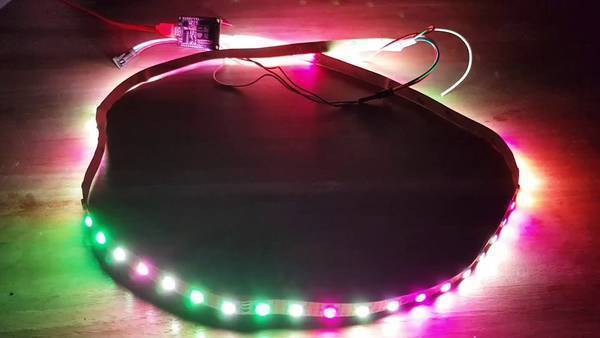
Soundlights with ESP8266 and NeoPixel Strip
"About a year ago I made soundlights with Raspberry Pi. But RPI is a bit of an overkill for this simple task and it’s quite big, doesn’t have WiFi out of the box and practically can’t be used without a power adapter. So I decided to port soundlights to ESP8266. The main idea was to reuse as much as possible from the previous implementation, so the parts with patched audio visualizer and colors generation are the same. In a few words, I’ve patched cava to print numbers instead of showing pretty bars in a terminal. And I’ve generated colors with a code found on Quora." [...]

IoT Air Freshner (with NodeMCU, Arduino, IFTTT and Adafruit.io)
"It's comforting to have a fragrant spring floral house, as if you were in the middle of a lavender garden instead of the concrete jungle where you probably live in. For this, many of the different companies have created air lovers with a multitude of aromas. There are lot of Air Freshners in the market: from the old manual sprays, to timer triggered ones. The later ones, although automatic, are quite dumb: they will keep spraying even if you're not even close to feel the smell, wasting those not so inexpensive fragrance refills! Wouldn't it be nice if your air freshner was capable of communicating with other gadgets and trigger only when you really needed it? In this project I designed an IoT Air Freshner, using some 3D printing, a NodeMCU, IFTTT and Adafruit.IO." [...]

Mojitonator - Easy, Cheap, Small Hydroponic System
"This is a very basic and easy hydroponic system to build. You will be drinking fresh mojitos all year long! The plant's roots grow in a nutrient solution aerated by an air pump with an air stone. You can put it on your patio, window sill or add artificial lighting for winter growing indoors. This is not only for minth. You could grow, basil, lettuce, hot peppers, etc." [...]

The World's First Fibre-Optic Candle Clock
"I decided to make my wife a present and wanted to come up with an original idea. I liked the idea of a moving sculpture and after much deliberation came up with the concept of a mechanical clock which twinkled and flashed using crystals, candles and fibre optics, controlled by a mechanism, rather than electronics. I can find no other use of candles with fibre-optic cable. I understand that this is likely to be because the light for a candle is not very powerful but all I wanted to create was a gentle twinkle so it sounded ideal for my purpose. The second picture shows the clock where it lives on the wall in our living room alongside an amazing picture by our wonderful friend Sophie Capron. As you can see, I have hung it from the picture rail using a brass picture hook." [...]
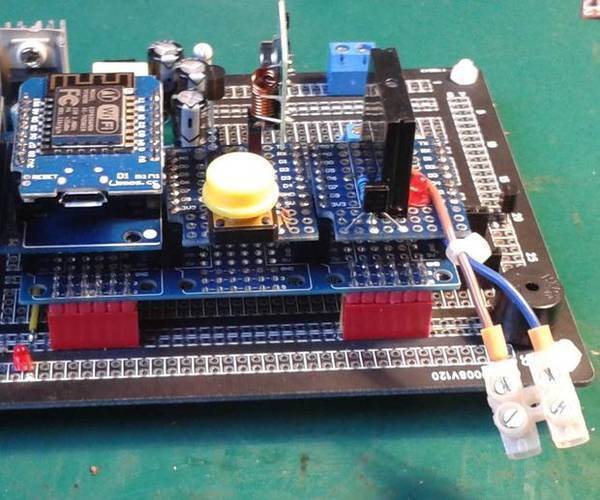
Set Up an ESP8266 Automatic Update Server
"Many people are now using the ESP8266 in its many guises (ESP-01S, Wemos D1, NodeMCU, Sonoff etc) for home automation systems. If you write your own code (as I do) updating each of these separately even via OTA (over the air) becomes a bit tedious. My own system, for example has 8x ESP-01S, 6x Wemos D1, 4x Sonoff Basic 12x Sonoff S20, 2x Sonoff SV and a NodeMCU which share a common code base, so that's 33 devices in all to update when I make a simple code change. But there is an easier way: An "update server". The excellent Arduino IDE + ESP8266 core has a library to do most of the work (ESP8266httpUpdate), but you need to know how to set up your own server to make it work. This Instructable shows you how using a NODE-RED server, but the same logic applies to any server technology of your choice e.g." [...]

Desktop Weather Station With WIFI
"Life is more than making a living. Life-Hacks and DIYs can make your days more enjoyable. By being a designer of your own house, you don't have to follow the latest fashion. For some time, simple changes make a big difference and can bring you great satisfaction. When tech, Open-source hardware and Design meet each other there would be amazing chemical reactions. We have to be kind to every single day of our life." [...]

Spooky WiFi LED Halloween Picture (using ESP8266)
"I was inspired to this project by the project "Spooky LED Halloween Sign" by K-Greenhalgh. After reading about this project, I thought "why shouldn't I use the ESP8266 to control the LEDs? I would be able to switch the LEDs on and off by my smartphone!". " [...]
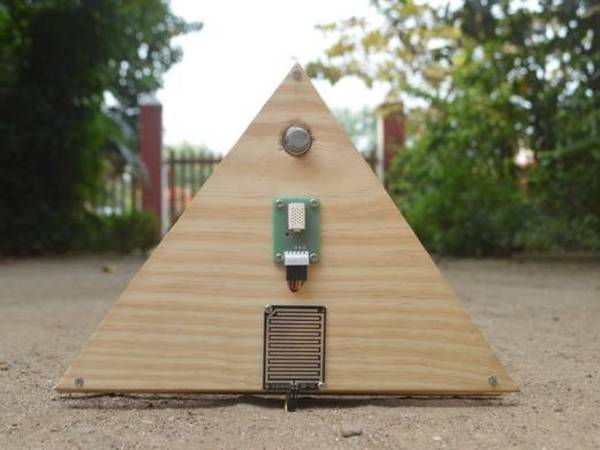
TWIST - Tweeting Weather Station
"TWIST is a DIY, Open-Source Environmental Monitoring and Meteorological Data Acquisition Platform which Tweets Local Data. Ever wanted to monitor your city's Current Weather Conditions, Carbon Footprint, Noise and Pollution levels? Do you want be a Climate Change Crusader or set-up your own Tweeting Weather Station and share your local weather conditions with the world? Meet Tweeting Weather IoT Station aka TWIST - a DIY, Open-Source Environmental Monitoring and Meteorological Data Acquisition Platform. The purpose of TWIST is so that individuals and communities can collect data of what's actually happening in their environment and share this data on social media such as Twitter. The brain of TWIST is an Intel Edison Board." [...]
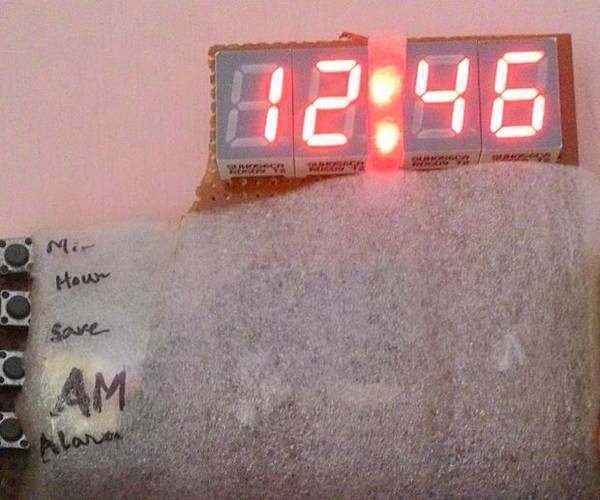
DIY Digital Clock Using Microcontroller (AT89S52 Without RTC Circuit)
"Lets describe a clock... "Clock is a device that counts and shows time(relative)"!!! Guess I said it right so lets make a CLOCK with ALARM feature. NOTE: it will take 2-3 minutes in reading please read the whole project or else I will not be responsible for any part damage. " [...]
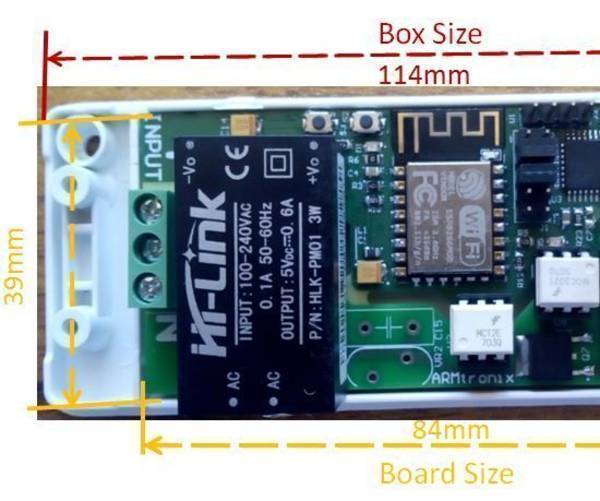
Wifi Two Triac Dimmer Board
"This instructable is for ARMTRONIX WIFI Two Triac Dimmer Board V0.1 Armtronix Wifi two triac dimmer is an IOT board. It is designed for home automation. The features of the board are: Wireless control Small form factor On board AC to DC power supp1y 230VAC to 5V DC. DC virtual switch Two channels(one for on and off another for dimming)The size of the board is 84mmX39mm and with box size 114 mmX44mm, as shown in diagram1, it has a capacity to drive upto 1 Amp load. The board has a Wifi module(Esp 12F) and microcontroller (atmega328p) same as that used in Arduino Uno , which is used to control the triac through HTTP or MQTT mode . The board has two DC virtual switches which can be used to control the two Triacs." [...]
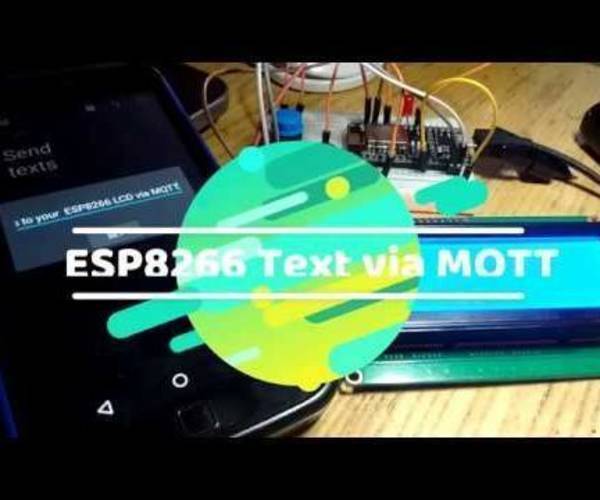
ESP8266/Arduino MQTT Memo Minder W/LCD (AKA Teenage Gamer Attention Getter!)
"Have teenagers who lock themselves away playing their online games with headphones on? Tired of them not hearing you yell for them or not answering their text messages or calls? Yeah...US TOO! That is what the motivation for my latest gizmo is driven by (Plus it was just fun to build). Park this little gem right in front of their screen. While it's quiet, it is just sitting there minding its own business." [...]
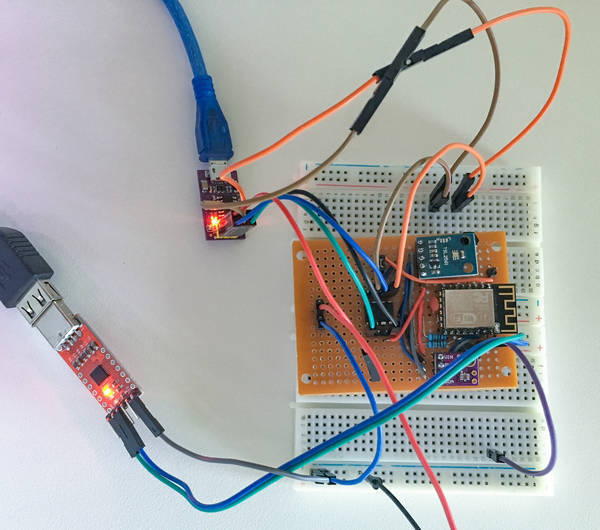
ESP8266 on batteries for years
"The ultra low power weather station For some time I have been fascinated by the possibilities of the ESP8266, but I never really considered it good for a life on batteries. I got an idea of making an outdoor weather station that would send measured light level, temperature and humidity to my home automation server. The ESP is a hungry beast when it’s doing WiFi. According to different sources on the internet it uses about 70 mA on average when WiFi is on! This would mean that I have to change batteries on my sensor quite some times every year. I instead came up with the idea of a design using an AtTiny85 for doing frequent measurements and then once in a while to wake up the ESP beast to transmit it’s recorded data to the server." [...]
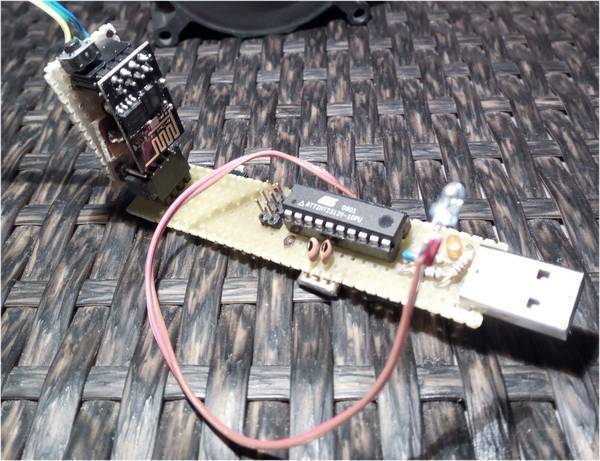
Your HotSpot is a presence detector
"I never connect my devices to “free wifi” hotspots. I’ve seen what a (bad) hacker can do, using one laptop, a battery powered Raspberry PI board and a collection of software tools. He can spy (almost) any smartphone that is connected to the same “free wifi” hotspot. For this reason, I always use my own LTE 4G connection and my smartphone is always enabled to share such internet connection with my other devices (one laptop, another smartphone and some other) using an access filter based on MAC address of every device. This is more secure than use “free wifi” hotspots and I suggest to everyone the same approach. However, this isn’t the subject of my post." [...]
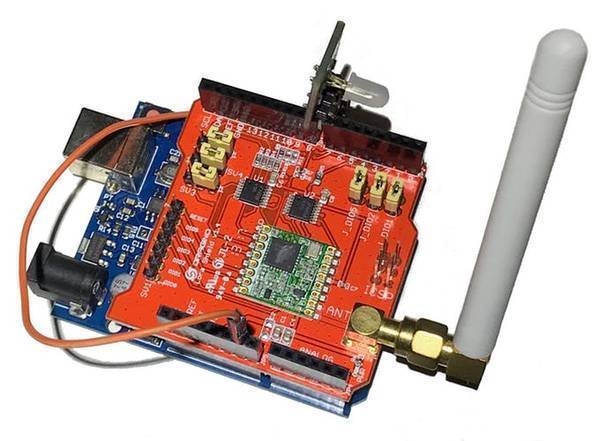
LoRa Gateway for DeviceHive
"You will learn how to build IoT devices using highly efficient and power saving radio technology. LoRa is a chirp spread spectrum (CSS) radio modulation technology which allows transmitting data over long distances with low power consumption. This technology is a perfect fit for communication with simple sensors across a local area like an industrial or agricultural zone. Low power consumption allows building battery-powered devices, which can operate for months or even years using a single battery. Therefore, such devices can be installed without any infrastructure, i.e. totally wirelessly." [...]

Arduino Nano Capacitance Meter
"This project is pratically three components because it's formed of a 16X2 LCD Display, a potentiometer 10K, and an Arduino Nano. The rest of parts are a PCB 5cm x 7cm, 1 X 40 HEADER, 0.1" SPACING, and 4-625" STAINLESS STEEL HEX STANDOFF, M-F, 6-32. In a nutshell, Capacitor Meter can measure from 0.000 to 1000uF. " [...]

Sends a Sms With Temperatur on Time
"The idea is to get a temperatur sms from my fathers house. Nothing fancy just quick putting parts together. The parts are : Geekcreit ATmega328P Nano V3 Controller Board Compatible Arduino DIY NANO IO Shield V1.O Expansion Board For Arduino DS1307 Based RTC IIC / I2C Real Time Clock Module and DS18b20 SIM800L Quad-band GSM / GPRS LM2596 Mini DC-DC Converter Adjustable Step Down Power Supply Module Thermistor NTC MF52AT temperature First at all a lot off reading and searching. " [...]

Arduino Wireless Power POV Display
"When I first met this little device, I liked it immediately. I decided to make my own POV. I watched lot of videos, and recognised some main problems. The power supplying of the micro-controller was the biggest. Spinning battery or sliding commutators were both refused. Only option was the air core coil for me." [...]
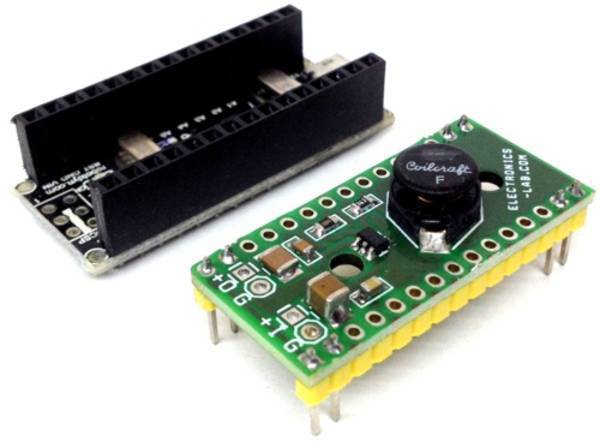
2 X AA Battery To 6V Boost Converter For Arduino Nano
"This project is simple solution to power Arduino Nano from two 1.5V batteries. Circuit converts 2 X AA alkaline battery power into 6V 100mA using boost topology. Circuit uses SOT223-6 pin TLV61046A boost converter IC. The TLV61046A is a highly integrated boost converter designed for applications such as PMOLED panel, LCD bias supply and sensor module. The TLV61046A integrates a 30-V power switch, an input to output isolation switch, and a rectifier diode. It can output up to 28 V from input of a Li+ battery or two alkaline batteries in series." [...]
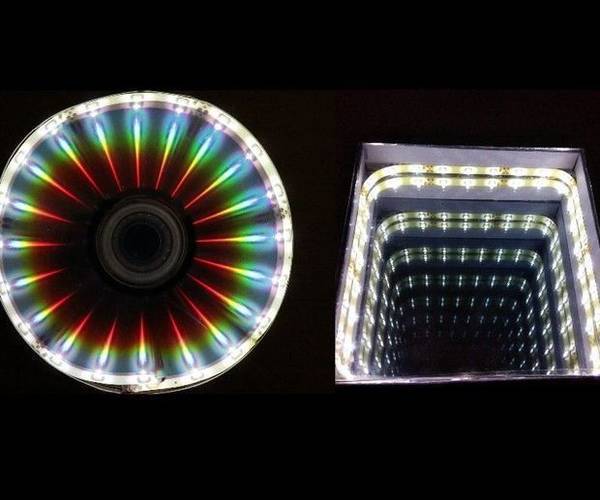
2 Amazing Ideas to Make LED Illusion Mirror- Easy Project Ideas
"Hello friends in this instructable ill be showing you 2 of the very easy and interesting project ideas which is really fun to make and Can Be Used For Decorative purposes.Both the Projects gives out stunning effects so find your time to build one for yourself. " [...]

Circuit Blocks in the Classroom
"This is part of a series of Instructables intended for teachers about educating students in the classroom around making and tinkering. For more about the details of this project, check out our blog. Learning about circuits and electricity can be an intimidating task - it seems so complicated! This activity involves the use of a modular set of electronic components that are easy to hook up to each other - like LEGOs for circuitry. In this Instructable, I will assume that you have already built the circuit block set and have a few of the basic components - battery, motor, knife switch, momentary switch, LED, speaker and potentiometer. The circuit combinations possible with a few of these components are almost endless, and any electronic component that you can glue onto a block of wood will work - take apart some old toys and add some of their working bits to this set, for example." [...]
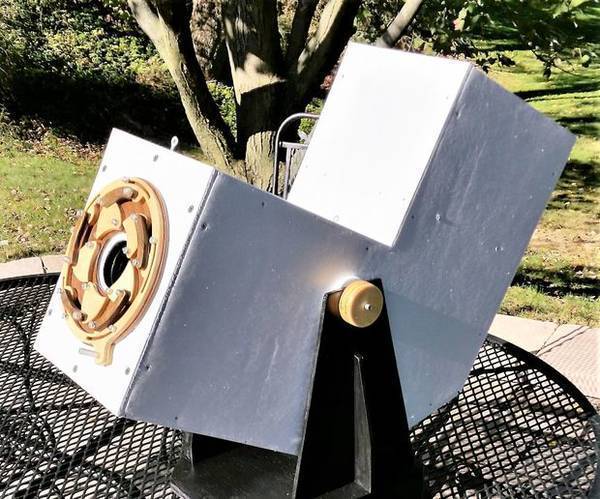
Building a Solar Projector
"All of the excitement surrounding 2017 solar eclipse was the catalyst I needed to motivate me to build my solar projector. I had always thought that it would make a neat project, but the up-coming eclipse gave me a reason to continue. However, after the eclipse was over, I discovered how much fun it was to view sunspots, so my enthusiasm for the project continued. " [...]
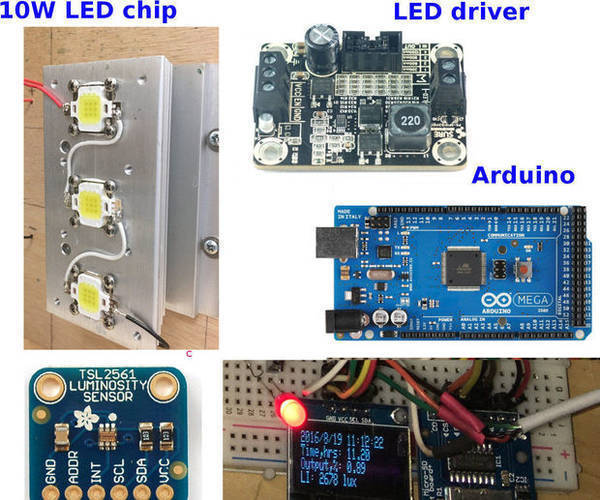
Control High-powered LED Panel by Arduino Real Time With Log Data, Luminosity Sensor, LCD Display
"Is this enough of LED controller around? Yes, there are many LED control guides we can find on the Internet. One objective of my quest was to control a powered LED panel with a defined profile light intensity and real-time clock, and a light sensor to double check the output of LED panel. The input, output of light intensity are logged into SD card for a post-analysis.What are the parts? Below are the parts I have in my projects, details will be present along the way.Optional: I want to mimic a profile of solar intensity, which depends on the region, and the reason. The profile is hours vs. intensity of light." [...]

The Pi Guardian
"Have you ever wanted to catch that one person who keeps stealing your Halloween candy? Or what about that annoying roommate who won't leave your fridge alone? By using a Raspberry Pi 3, Pi Camera, and PIR sensor, all of that is now possible. Simply put it in a location you want monitored and get emailed with an attached photo of the perpetrator. " [...]
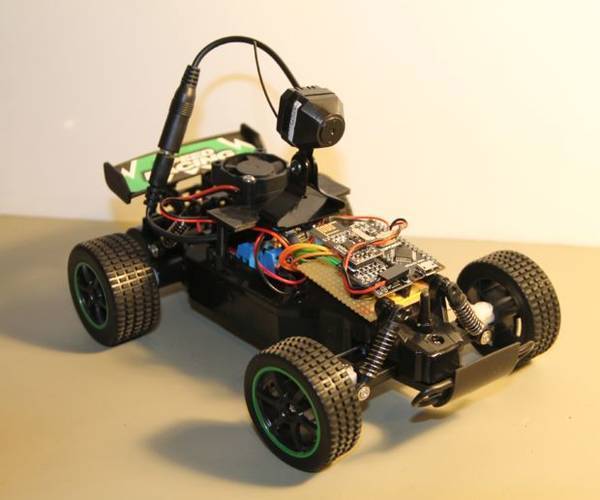
FPV RC Car
"This project is in in my drawer for some time and I since Maker Fair is coming to town, this was a good time to make it. A long time ago, there was a game called "Micro Machines" for Sega Mega Drive (Genesis) that I spend hours playing. Basically this was a racing game with small cars where the race track was parts of daily life objects. I found that there is a new version of this old classic. On the original version, the game had top view of the track and cars, but I wanted to had the first person view in a head display. The camera would move according to the movement of the head of the player." [...]
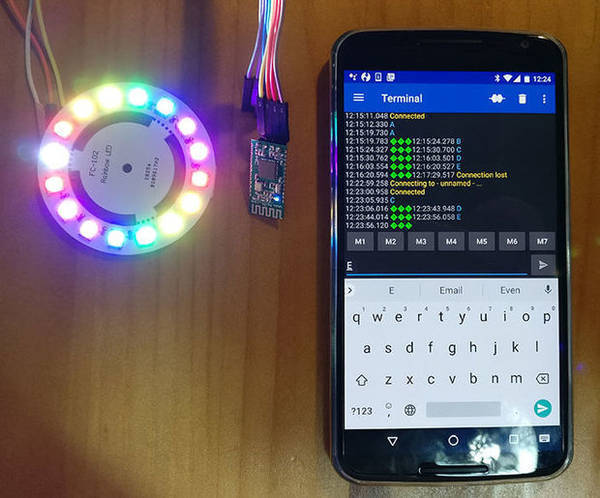
Use Bluetooth 4.0 HC-08 Module to Control Addressable LEDs - an Arduino Uno Tutorial
"Have you delved into communication modules yet with Arduino? Bluetooth opens up a world of possibility for your Arduino projects and using the internet of things. Here we'll start with a baby step and learn how to control addressable LEDs with a smartphone app using an HC08 Bluetooth module. Afterwards, you'll be familiar with a smartphone app you can use to control other modules with Bluetooth. What you'll need for this tutorial:Hardware: -Arduino UNO -LED RING 16 X 5050 RGB WS2812 -Dupont wires -Male Headers -HC-08 Bluetooth module Software: -Arduino IDE -Example code -NeoPixel Library -Android application to control the ring (I used Serial Bluetooth Terminal for this tutorial) Tools: -Soldering iron The benefits of using BLE The HC-08 module uses BLE (Bluetooth Low Energy) protocol. The main difference between Bluetooth and BLE is power consumption." [...]
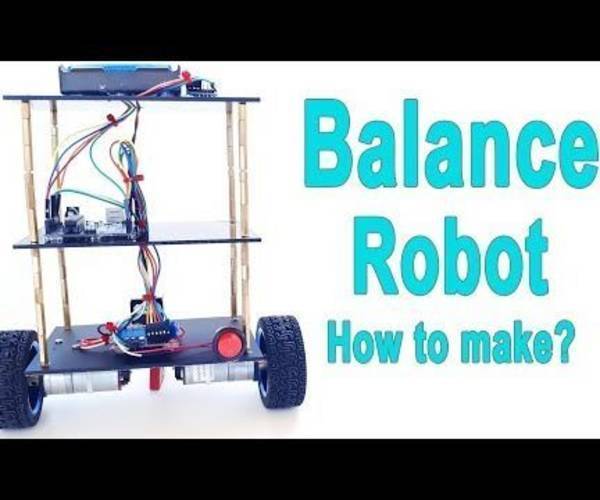
Arduino - Balance - Balancing Robot | How to Make?
"In this tutorial we will learn how to make Arduino balancing (balance) robot that balances itself. First you can look at the video tutorial above. " [...]
Raspberry Pi Wifi Controlled Video Streaming Robot
"Ever thought about building a cool robot with a camera on it ? Well, you came to the right place, I will show you step by step about how to build this robot. With this you can go ghost hunting at night by controlling and seeing the video feed on your computer or drive it outside and just explore while sitting inside, it is very fun to drive. " [...]

Nixie Clock on ESP8266 module
"Nixie Clock on ESP8266 module with synchronization with NTP server. Simple circuit. This is my new project "Nixie clock on ESP8266". Here I used the decoder 74141 and the neon indicators IN-12. Features: 1) Powered by USB port. Low energy consumption." [...]
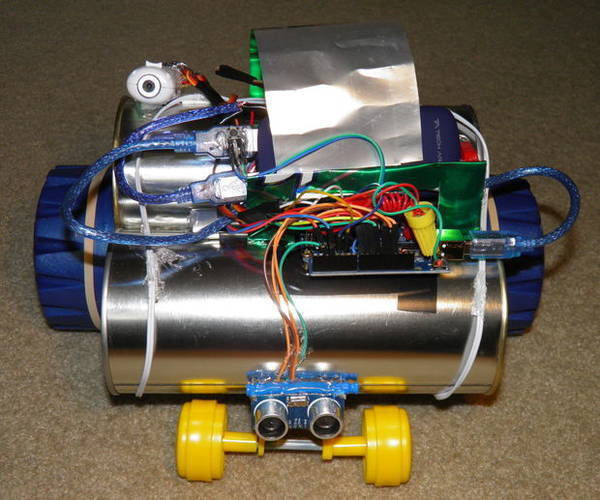
Industrial AI Robot
"The Industrial Grade Artificial Intelligence Robot! Here you will learn how to build a very sturdy robot to take video of your house when you are not home. I built this robot to show people how to build cool robots without spending too much money. Most of the materials in this robot is recyclable and easy to build. The robot we will be building will be able to avoid objects, take video and move in random patterns. This way of moving can make the robot enter hallways and doorways without being too predictable like most robots." [...]
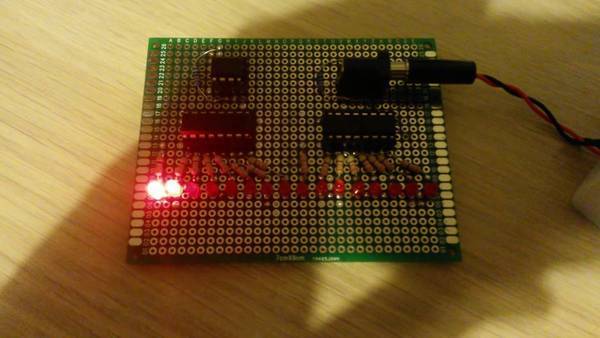
ATtiny85 And Shift Registers
"I decided I wanted to play with shift registers, and the classic circuit for that is running a bunch more LED’s from a chip than the chip has pins, so I decided on an 8 pin ATtiny85 running 16 LED’s as a Larson scanner (Knight Rider or Cylon effect). I started out on breadboard which was a terrible mistake as I ended up needing two breadboards to provide enough space to run 16 LED’s via resistors all with a shared GND. Should have gone straight to perfboard (I think veroboard would have the same problem as breadboard due to solid tracks instead of pads). The shiftOut() function takes a bit of getting used to, especially when using two 74HC595 shift registers so need to output 16 bits instead of an 8-bit byte (and when it takes an hour of playing with code to realise one of the chip’s output pins it busted!) and for some reason when moving from breadboard to perfboard I had to change the code to use MSBFIRST instead of LSBFIRST or it would run the LED sequence on each chip instead of across the two…..?! " [...]

Arduino Voice Recognition Remote Control Car/Spider Robot/BB8... Nearly Everything
"I wanted to control my RC 360 Degree Stunt Car (which is also the motor unit I've built for my RC Lego BB8), sing my voice, but keeping the functionality of the original Remote Control, so, here it is! " [...]
That's all Folks!


